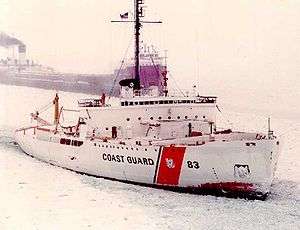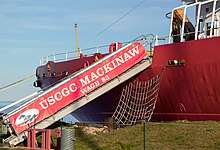USCGC Mackinaw (WAGB-83)
USCGC Mackinaw (WAGB-83) is a 290-foot (88 m) vessel specifically designed for ice breaking duties on the Great Lakes. LR number: 6119534 According to the Ice Breaker Mackinaw Maritime Museum, the vessel has been known as the "Queen of the Great Lakes" and "The Largest Icebreaker on the Great Lakes"; the site states that "she was built ... during World War II to meet the heavy demands of war materials and transportation during the winter months".[3]
 USCGC Mackinaw. | |
| History | |
|---|---|
| Name: | USCGC Mackinaw |
| Namesake: | Mackinaw City, Michigan |
| Builder: | Toledo Shipbuilding Company |
| Laid down: | 20 March 1943 |
| Launched: | 4 March 1944 |
| Commissioned: | 20 December 1944[1][2] |
| Decommissioned: | 10 June 2006 |
| Identification: |
|
| Fate: | Museum ship |
| General characteristics | |
| Displacement: | 5,252 long tons (5,336 t) |
| Length: | 290 ft (88 m) |
| Beam: | 74.3 ft (22.6 m) |
| Draft: | 19.5 ft (5.9 m) |
| Propulsion: |
|
| Speed: | 15 kn (28 km/h; 17 mph) |
| Capacity: |
|
| Complement: | 8 Officers, 67 Enlisted |
| Notes: | Two 6,000 lb (2,700 kg) Bower Stockless anchors with 2-inch-diameter (51 mm) links. |

Mackinaw was homeported in Cheboygan, Michigan during active service. Due to Mackinaw's age and expensive upkeep, the cutter was decommissioned and replaced with a smaller multipurpose cutter USCGC Mackinaw (WLBB-30), which was commissioned in Cheboygan the same day.
In 2002 the crew of this cutter painted and refurbished the Fourteen Foot Shoal Light.[4]
The old Mackinaw moved under its own power on 21 June 2006 from the port of its decommissioning to a permanent berth at the SS Chief Wawatam dock at the ship's namesake port, Mackinaw City, Michigan where she now serves as a museum ship known as Icebreaker Mackinaw Maritime Museum. The vessel is docked on the eastern end of the old railroad dock; entry to the dock area is just south of the Shepler’s Marine Service.[5]
Construction
The Mackinaw (WAGB-83) was laid down on 20 March 1943 at Toledo Shipbuilding Company in Toledo, Ohio, launched (sideways) on 4 March 1944, and commissioned on 20 December 1944. Due to the WWII war efforts Toledo area Male workers were at an all time low. The shipyard opened their hiring to Toledo area Women, they initially hired 12 'helpers' within a short time and eventually hired over 100 women workers. [6] Mackinaw’s design was based on the Wind class of Coast Guard icebreakers, but the cutter was built wider and longer than the other Wind-class vessels so that her draft would be shallower. Because she was built specially for the Great Lakes — she was too wide to fit through the pre-1959 Saint Lawrence Seaway — her hull was built lighter than the Wind-class vessels, but shared many characteristics, such as a relatively short length in proportion to the great power developed, a cut-away forefoot, rounded bottom, and fore, aft and side heeling tanks. Diesel electric machinery was chosen for its controllability and resistance to damage, and she also had a bow propeller. The original blueprints of the Mackinaw called for 300 ft in length. She was built with a length of 290 ft.[7][8]
Amateur radio

The Charlevoix, Cheboygan, Emmet Counties Public Service Communications Organization (CCECPSO), has established a full-time amateur radio station on board the Icebreaker Mackinaw Maritime Museum.[9]
The CCECPSCO has two repeaters on Mackinaw to provide communications coverage throughout the Straits of Mackinac. These repeaters, operating under the call-sign W8AGB to match the ship's WAGB-83 designation, are on a radio frequency of 145.110 MHz with 103.5 Hz PL tone and 444.375 MHz with 107.2 Hz PL tone. The organization is also actively assisting the museum with restoration and operation of various communications, navigation, and power systems. Included with the radios on board the ship are two Sunair RT-9000 HF transceivers with matching antenna couplers and vertical antennas. Scheduled for spring 2010 is the installation of a third RT-9000 paired with an LPA-9600 solid-state kilowatt amplifier and CU-9100 kilowatt autotuner along with a Sunair F-9800 automatic pre/post filter for each radio to permit simultaneous operation of all three stations, and Sunair RCU-9310 remote control panels.
The vessel is equipped with a 160-40 Meter Dipole, antenna couplers and vertical antennas linked to the two Sunair RT-9000 transceivers. The CCECPSCO group planned to add extra antennae for VHF and UHF repeater use and a KC8TU customized wire antenna.[10]
Amateur radio operators visiting Mackinaw may operate the W8AGB station whenever a CCECPSCO member is present. The CCECPSCO conducts Amateur Radio Field Day operations from Mackinaw on the fourth full weekend in June.
Museum

The museum provides educational tours and overnight stays on the vessel. Visitors can tour the mess deck, the captain's quarters, bridge, engine room, ward room, sick bay and other areas. A retail store on the vessel sells relevant products.[11]
A fee is charged to visitors but all current and former USCG personnel are admitted free; proper identification must be provided.[12]
Awards
- American Campaign Medal -

- World War II Victory Medal -

- National Defense Service Medal with three service stars -




- Global War on Terrorism Service Medal -

List of Captains
WAGB 83 had 30 skippers during her nearly 62-year career:
- Cmdr. Edwin J. Roland 1944–46
- Cmdr. Carl H. Stober 1946–47
- Capt. Harold J. Doebler 1947–49
- Capt. Carl G. Bowman 1949–50
- Capt. Dwight H. Dexter 1950–52
- Cmdr. Willard J. Smith 1952–54
- Capt. Clifford R. Maclean 1954–56
- Capt. Evor S. Kerr 1956–58
- Capt. John P. German 1958–60
- Capt. Joseph Howe 1960–62
- Capt. Benjamin Chiswell, Jr. 1962–64
- Capt. George H. Lawrence 1964–66
- Capt. George D. Winstein 1966–68
- Capt. Otto F. Unsinn 1968–70
- Capt. Lilbourn A. Pharris, Jr. 1970–72
- Capt. John H. Bruce 1972–74
- Capt. Lawrence A. White 1974–76
- Capt. Donald D. Garnett 1976–78
- Capt. Gordon Hall 1978–80
- Capt. Francis J. Honke 1980–83
- Capt. P.R. Taylor 1983–85
- Capt. A. H. Litteken, Jr. 1985–88
- Lcdr. J. J. McQueeney II 1988–89
- Capt. A. H. Litteken, Jr. 1989–89
- Capt. R. J. Parsons 1989–92
- Capt. C. A. Swedberg 1992–95
- Cmdr. K. R. Colwell 1995–98
- Cmdr. E. Sinclair 1998–2000
- Cmdr. J. H. Nickerson 2000–03
- Cmdr. Joseph C. McGuiness 2003–06
Notes
- "USCGC Mackinaw (WAGB-837)". Historic Naval Ships Association. 14 May 2014. Archived from the original on 3 May 2015. Retrieved 17 May 2015.
- "USCGC Mackinaw - Cutter History". United States Coast Guard. 9 February 2015. Archived from the original on 2 April 2015. Retrieved 17 May 2015.
- https://www.themackinaw.org/ Archived 2019-06-23 at the Wayback Machine, Museum - Our Mission
- Rowlett, Russ. "Lighthouses of the United States: Michigan's Eastern Lower Peninsula". The Lighthouse Directory. University of North Carolina at Chapel Hill.
- https://www.themackinaw.org/museum-info/ Archived 2019-06-23 at the Wayback Machine, Museum Info
- personally family knowledge my mother was one of the first 12 women hired
- "Mackinaw, 1944" (PDF). U.S. Coast Guard Cutter History. United States Coast Guard. Archived (PDF) from the original on 4 March 2016. Retrieved 17 May 2015.
- Canney, Donald L. "Icebreakers and the U.S. Coast Guard". Historian's Office. United States Coast Guard. Archived from the original on 1 July 2015. Retrieved 17 May 2015.
- http://www.ccecpsco.org/icebreaker-mackinaw-6/ Archived 2019-06-23 at the Wayback Machine, Icebreaker Mackinaw Museum Ship - W8AGB
- http://www.ccecpsco.org/icebreaker-mackinaw-6/, Icebreaker Mackinaw Museum Ship - W8AGB
- https://www.themackinaw.org/ Archived 2019-06-23 at the Wayback Machine, Our Mission
- https://www.themackinaw.org/museum-info/, Museum Info
References
External links
- Icebreaker Mackinaw Maritime Museum official site
- Many photos of the Mackinaw in operation and as a museum ship
- Charlevoix, Cheboygan, Emmet Counties Public Service Communications Organization
| Wikimedia Commons has media related to IMO 8640210. |